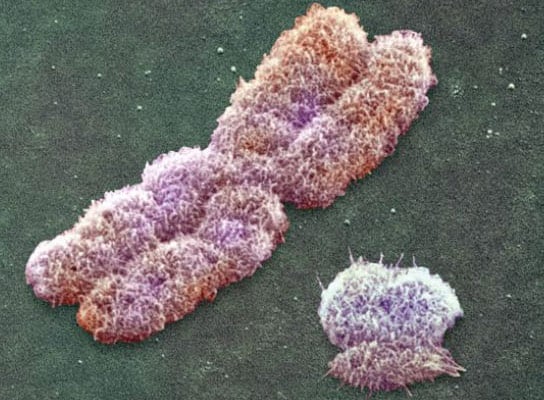
Geneticists at the University of Arizona have discovered an African American Y chromosome with lineage that diverged from previously known Y chromosomes about 338,000 ago, pushing back the time the last common Y chromosome ancestor lived by almost 70 percent.
University of Arizona (UA) geneticists have discovered the oldest known genetic branch of the human Y chromosome – the hereditary factor determining male sex.
The new divergent lineage, which was found in an individual who submitted his DNA to Family Tree DNA, a company specializing in DNA analysis to trace family roots, branched from the Y chromosome tree before the first appearance of anatomically modern humans in the fossil record.
The results are published in the American Journal of Human Genetics.
“Our analysis indicates this lineage diverged from previously known Y chromosomes about 338,000 ago, a time when anatomically modern humans had not yet evolved,” said Michael Hammer, an associate professor in the University of Arizona’s department of ecology and evolutionary biology and a research scientist at the UA’s Arizona Research Labs. “This pushes back the time the last common Y chromosome ancestor lived by almost 70 percent.”
Unlike the other human chromosomes, the majority of the Y chromosome does not exchange genetic material with other chromosomes, which makes it simpler to trace ancestral relationships among contemporary lineages. If two Y chromosomes carry the same mutation, it is because they share a common paternal ancestor at some point in the past. The more mutations that differ between two Y chromosomes the farther back in time the common ancestor lived.
Originally, a DNA sample obtained from an African American living in South Carolina was submitted to the National Geographic Genographic Project. When none of the genetic markers used to assign lineages to known Y chromosome groupings were found, the DNA sample was sent to Family Tree DNA for sequencing. Fernando Mendez, a postdoctoral researcher in Hammer’s lab, led the effort to analyze the DNA sequence, which included more than 240,000 base pairs of the Y chromosome.
Hammer said “the most striking feature of this research is that a consumer genetic testing company identified a lineage that didn’t fit anywhere on the existing Y chromosome tree, even though the tree had been constructed based on perhaps a half-million individuals or more. Nobody expected to find anything like this.”
About 300,000 years ago, the time the Neanderthals are believed to have split from the ancestral human lineage. It was not until more than 100,000 years later that anatomically modern humans appear in the fossil record. They differ from the more archaic forms by a more lightly built skeleton, a smaller face tucked under a high forehead, the absence of a cranial ridge, and smaller chins.
Hammer said the newly discovered Y chromosome variation is extremely rare. Through large database searches, his team eventually was able to find a similar chromosome in the Mbo, a population living in a tiny area of western Cameroon in sub-Saharan Africa.
“This was surprising because previously the most diverged branches of the Y chromosome were found in traditional hunter-gatherer populations such as Pygmies and the click-speaking KhoeSan, who are considered to be the most diverged human populations living today.”
“Instead, the sample matched the Y chromosome DNA of 11 men, who all came from a very small region of western Cameroon,” Hammer said. “And the sequences of those individuals are variable, so it’s not like they all descended from the same grandfather.”
Hammer cautions against popular concepts of “mitochondrial Eve” or “Y chromosome Adam” that suggest all of humankind descended from exactly one pair of humans that lived at a certain point in human evolution.
“There has been too much emphasis on this in the past,” he said. “It is a misconception that the genealogy of a single genetic region reflects population divergence. Instead, our results suggest that there are pockets of genetically isolated communities that together preserve a great deal of human diversity.”
Still, Hammer said, “It is likely that other divergent lineages will be found, whether in Africa or among African-Americans in the U.S. and that some of these may further increase the age of the Y chromosome tree.”
He added: “There has been a lot of hype with people trying to trace their Y chromosome to different tribes, but this individual from South Carolina can say he did it.”
Reference: “An African American Paternal Lineage Adds an Extremely Ancient Root to the Human Y Chromosome Phylogenetic Tree” by Fernando L. Mendez, Thomas Krahn, Bonnie Schrack, Astrid-Maria Krahn, Krishna R. Veeramah, August E. Woerner, Forka Leypey Mathew Fomine, Neil Bradman, Mark G. Thomas, Tatiana M. Karafet and Michael F. Hammer, 28 February 2013, American Journal of Human Genetics.
DOI: 10.1016/j.ajhg.2013.02.002
The study came about by combined efforts of a private business, Family Tree DNA, the efforts of a citizen scientist, Bonnie Schrack, and the research capabilities at the UA.
Never miss a breakthrough: Join the SciTechDaily newsletter.
1 Comment
One of the dominants effects on the genes are red and
Black skin,very strong in the
evolution and it’s effect on
Hereditary development that in the moment of conception could bring the genes from ancestors that are very ancient.